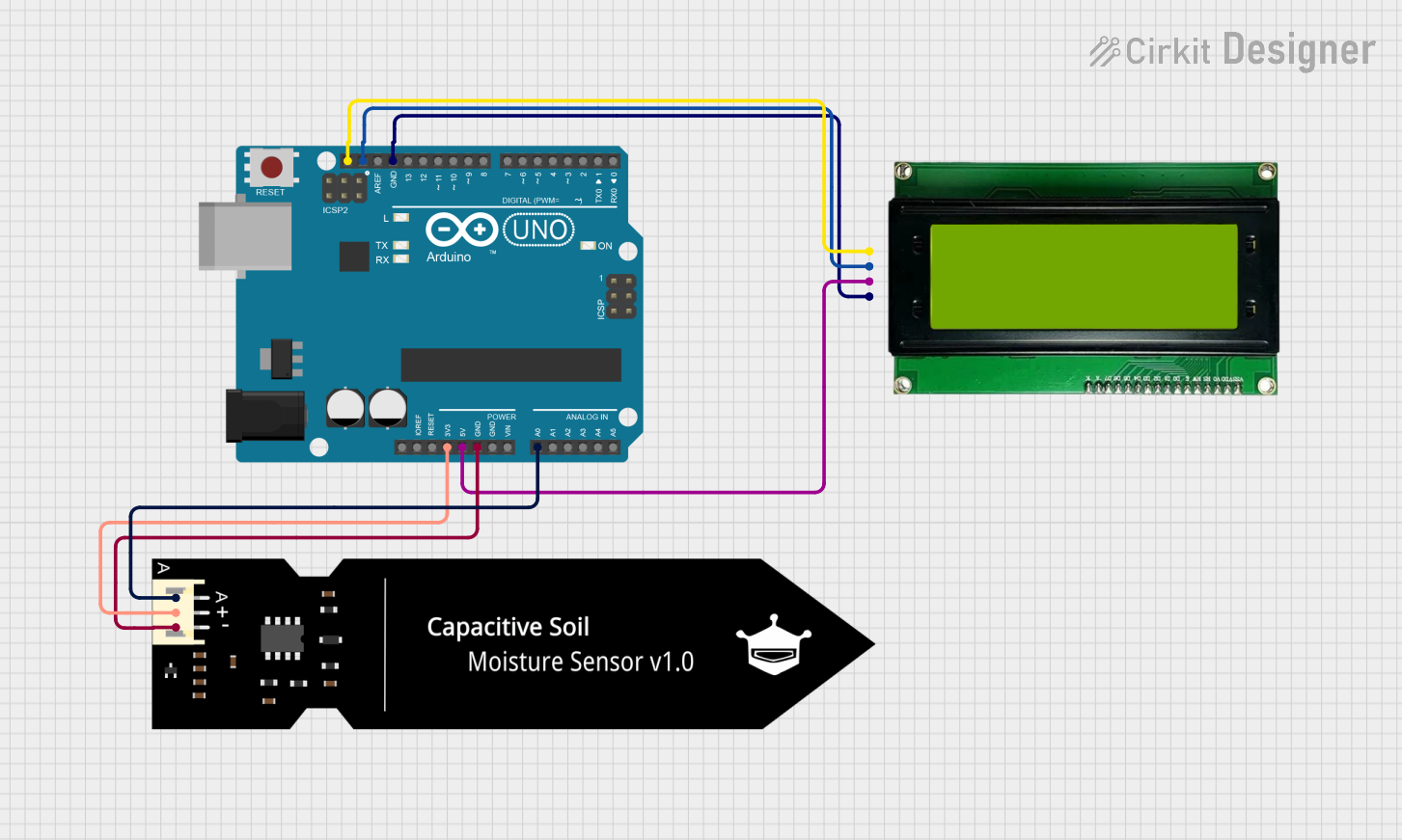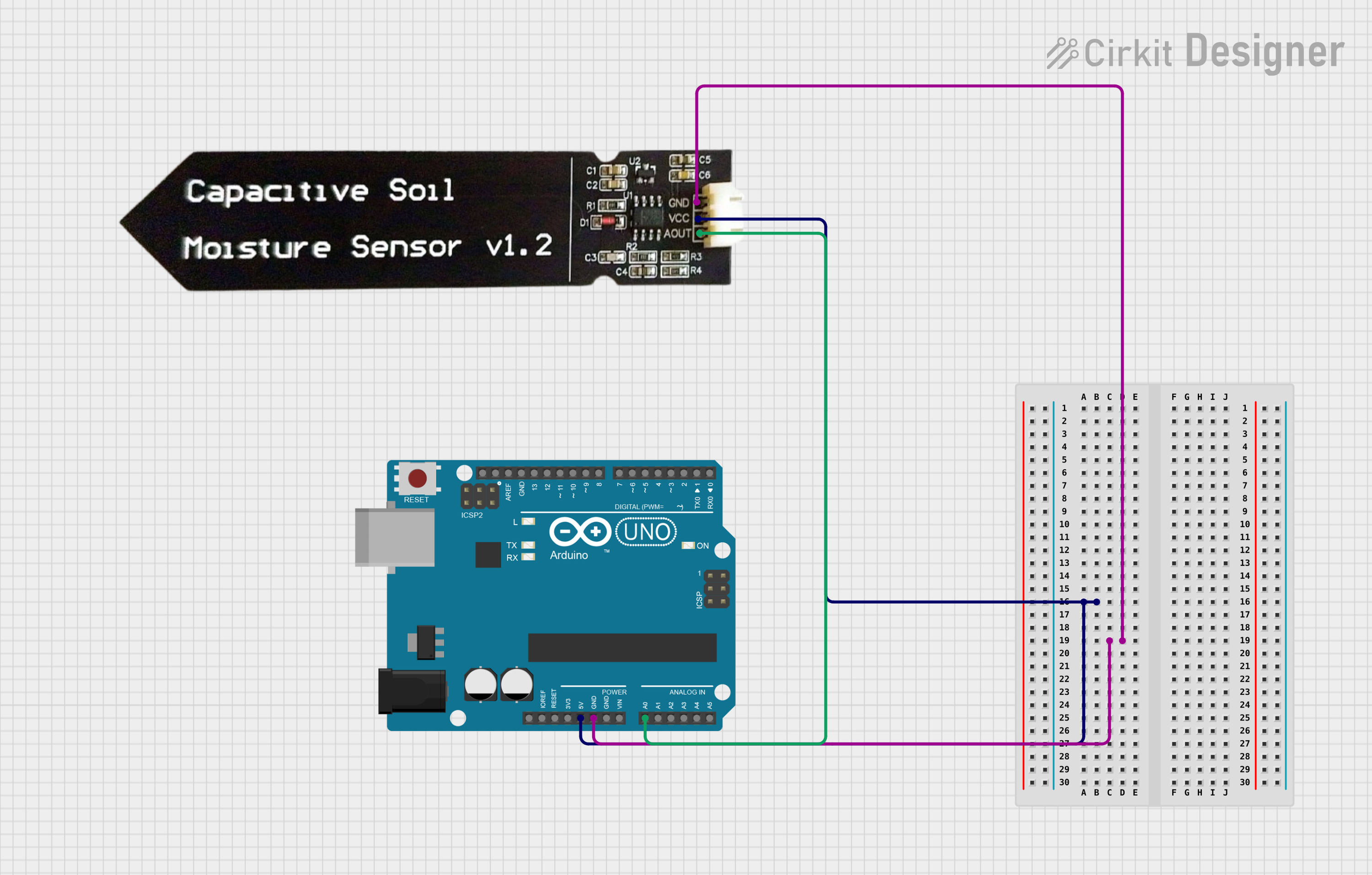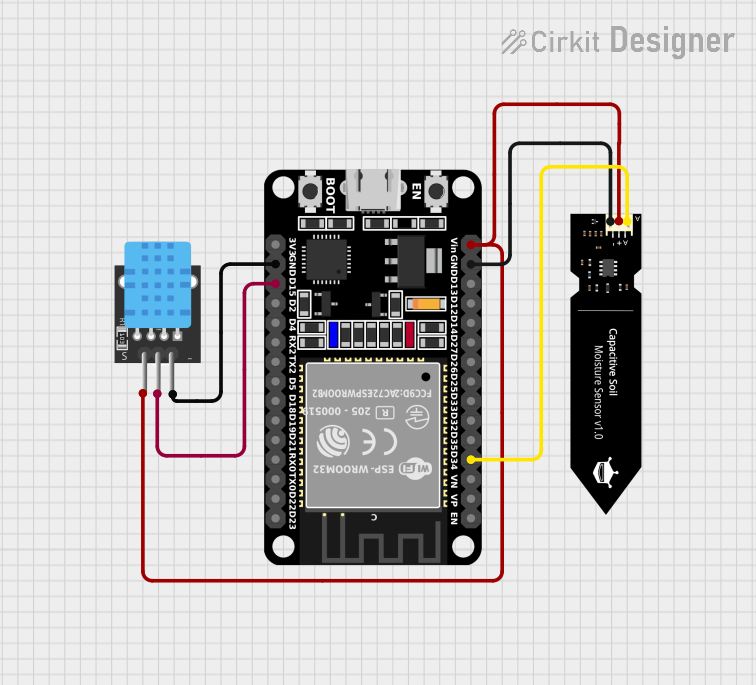
How to Use DFRobot Capacitive Soil Moisture Sensor (V1.0): Examples, Pinouts, and Specs

 Design with DFRobot Capacitive Soil Moisture Sensor (V1.0) in Cirkit Designer
Design with DFRobot Capacitive Soil Moisture Sensor (V1.0) in Cirkit DesignerIntroduction
The DFRobot Capacitive Soil Moisture Sensor (V1.0) is an electronic device that measures the moisture content in soil. Unlike resistive soil moisture sensors, which determine moisture by passing current through the soil, the capacitive sensor measures the changes in capacitance caused by the dielectric constant of the soil, which changes with moisture content. This method offers the advantage of not corroding over time, as there is no direct electrical contact with the soil.
Explore Projects Built with DFRobot Capacitive Soil Moisture Sensor (V1.0)

 Open Project in Cirkit Designer
Open Project in Cirkit Designer
 Open Project in Cirkit Designer
Open Project in Cirkit Designer
 Open Project in Cirkit Designer
Open Project in Cirkit Designer
 Open Project in Cirkit Designer
Open Project in Cirkit DesignerExplore Projects Built with DFRobot Capacitive Soil Moisture Sensor (V1.0)

 Open Project in Cirkit Designer
Open Project in Cirkit Designer
 Open Project in Cirkit Designer
Open Project in Cirkit Designer
 Open Project in Cirkit Designer
Open Project in Cirkit Designer
 Open Project in Cirkit Designer
Open Project in Cirkit DesignerCommon Applications and Use Cases
- Agriculture and gardening to monitor soil moisture for optimal plant growth
- Automated watering systems
- Environmental monitoring
- Educational projects to demonstrate soil moisture sensing
Technical Specifications
Key Technical Details
- Operating Voltage: 3.3 - 5.5 VDC
- Output Voltage: 0 - 3.0V
- Interface: Analog
- Current: 5mA
- Sensing Depth: ~38mm
- Operating Temperature: 10°C to 30°C
Pin Configuration and Descriptions
| Pin Number | Name | Description |
|---|---|---|
| 1 | VCC | Power supply (3.3 - 5.5 VDC) |
| 2 | GND | Ground connection |
| 3 | AOUT | Analog output signal |
Usage Instructions
How to Use the Component in a Circuit
- Connect the VCC pin to the 3.3V or 5V output on your microcontroller board.
- Connect the GND pin to the ground on your microcontroller board.
- Connect the AOUT pin to an analog input pin on your microcontroller.
Important Considerations and Best Practices
- Avoid submerging the sensor completely in water or wetting the onboard circuitry, as it is not waterproof.
- Calibrate the sensor for the specific soil type to get accurate readings.
- Use a pull-up resistor if you experience unstable readings.
- To prevent corrosion, do not leave the sensor in the soil for extended periods when not in use.
Example Code for Arduino UNO
// Define the sensor pin
const int sensorPin = A0;
void setup() {
// Initialize serial communication at 9600 baud rate
Serial.begin(9600);
}
void loop() {
// Read the value from the sensor
int sensorValue = analogRead(sensorPin);
// Convert the analog reading to a voltage value
float voltage = sensorValue * (5.0 / 1023.0);
// Print the voltage
Serial.print("Voltage: ");
Serial.println(voltage);
// Wait for a second before reading again
delay(1000);
}
Troubleshooting and FAQs
Common Issues Users Might Face
- Inconsistent Readings: Ensure that the sensor is properly calibrated for the soil type. Check for loose connections and use a pull-up resistor if necessary.
- Sensor Corrosion: Even though the sensor is capacitive and less prone to corrosion, avoid leaving it in the soil for long periods when not in use.
- No Readings: Verify that the sensor is connected correctly with the correct polarity and that the microcontroller is supplying power.
Solutions and Tips for Troubleshooting
- If the sensor provides erratic readings, stabilize the power supply with a capacitor across the VCC and GND pins.
- For calibration, take readings in completely dry soil and fully submerged in water to establish the sensor's range.
- Ensure the analog input pin on the microcontroller is functioning correctly by testing it with a known voltage source.
FAQs
Q: Can the sensor be used with a 5V microcontroller like the Arduino UNO? A: Yes, the sensor can operate on 3.3V to 5.5V, making it compatible with both 3.3V and 5V microcontrollers.
Q: How do I calibrate the sensor for accurate moisture readings? A: Take readings in known conditions (completely dry and fully wet soil) and map these to the sensor's output range to create a calibration curve.
Q: Is the sensor waterproof? A: The sensor probe is water-resistant, but the onboard circuitry is not waterproof. Avoid getting the electronic components wet.
Q: How long can I leave the sensor in the soil? A: While the capacitive design reduces corrosion risk, it is still recommended to remove the sensor from the soil when not actively taking measurements to extend its lifespan.